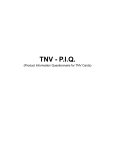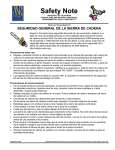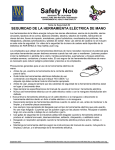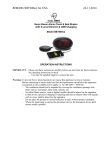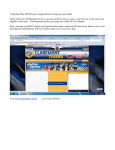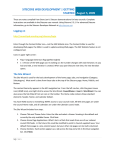Transcript
CLOVER SAFE AGRICULTURE AND NATURAL RESOURCES ENVIRONMENTAL HEALTH AND SAFETY #4 POWER SAW SAFETY Clover Safe notes are intended primarily for 4-H volunteers and members nine years and older. Information available from the U.S. Consumer Product Safety Commission indicates more than 12,000 people were treated in hospitals for power saw injuries during 2005. Typical injuries were cuts to fingers and hands and foreign objects striking or being lodged in eyes. There are three types of power saws that differ from each other based on how the saw blade cuts or moves into the stock being cut. The three types are circular blade saws, reciprocating saws, and continuous band saws. Power saws may be stationary by being mounted to tables/benches or portable/hand held. This Clover Safe information sheet is not intended to address chain saw safety. Photograph Courtesy of Kearney REC Power Saw Precautions: Prior to use, inspect power saw for damage or disrepair, including the electrical cord and plug. If the power saw fails your inspection, inform your group leader, parent, or guardian and remove it from use. Follow the user’s manual specifications when operating a power saw. Always wear industrial-quality safety glasses or a face shield when using power saws. Do not wear loose fitting clothing or jewelry that can be caught by moving parts. Pull back long hair with a band or wear long hair under a cap. As appropriate, wear suitable hearing protection and/or a dust mask. Keep saw fences, blade guards, spreaders, and anti-kick devices in place and functioning properly. Never use a saw that has had a guard or other safety device removed. Assure saw blades are clean, sharp, and correctly set so that they will cut freely without forcing the work piece against the blade. Use the proper saw blade for the material being cut. Keep focused on the cut you are making and do not look away from your work while operating a power saw. Never feed the work piece faster than the saw can accept. Prior to sawing, check stock for nails, screws, or other foreign objects. Assure that the table saw blade is set slightly above the thickness of the stock to be cut. Use a push stick to cut short or thin pieces of stock on a table saw. Never make free-hand cuts with a table saw. Guide stock using a rip fence or miter gauge. Never reach behind, over, or under a saw blade unless it has stopped turning and the power has been disconnected. Never carry a portable power saw with your finger on the trigger switch. Always disconnect the power source before changing or adjusting the saw blade. When finished, clean saw dust and scrap stock from the work area (including the floor) and dispose of in the trash or scrap recycling container. If you are injured by a saw, notify your project leader, parent, or Photograph Courtesy of guardian. Seek medical attention if the injury is serious. Lindcove REC September 2006 Additional EH&S information may be accessed at the ANR Web Site at: http://safety.ucanr.org



